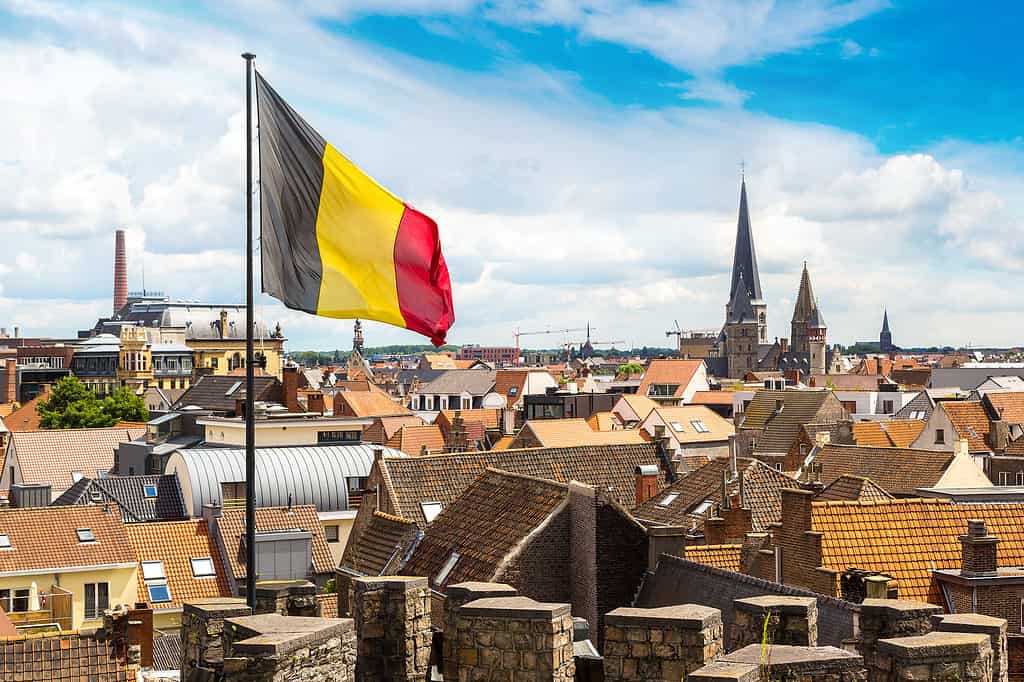Belgium is a Western European country renowned for its Renaissance architecture and medieval towns. It currently serves as the headquarters of NATO and the EU. Beyond its description and meaning, the flag of Belgium holds much symbolism, with a rich history and a background that goes beyond the country’s fight for independence.
Today’s piece explores the Belgian flag’s history, how it ended up bearing the famous black, yellow, and red tricolor, along with what these colors represent and what the flag means for Belgium and its citizens.
History of the Region
The Belgian national flag’s tricolor design resulted from revolutionary inspiration from the Brabant Revolution of 1789. The revolution marked the country’s fight for freedom long before modern-day Belgium would become independent in 1830.
After the Treaty of Rastatt in 1914, Imperial Spain ceded the Austrian Netherlands to Austria as part of the deal. The Austrian Netherlands was a territory that covered modern-day Luxembourg and Belgium. As part of the Holy Roman Empire, the Austrian Netherlands was unified under the federation of autonomous regions in Central Europe. These territories occupied today’s Germany, Austria, Czech Republic, Belgium, and Slovenia.
In 1784, the Holy Roman Emperor Joseph II launched a series of radical reforms in politics, economics, and religion aimed at modernization. Unfortunately, many of these reforms did not receive support, especially considering the Austrian Netherlands had a tiny Catholic minority. The reforms were also quite unpopular since most of the Austrian Netherlands saw them as a foreign phenomenon imposed on traditional local values.
With most of the population fused with anger, dissent grew to public opposition, with the wave centering around the provincial states of Brabant, Hainaut, and Flanders. The three provincial states and their law courts, mainly Brabant, would be at the forefront of the Holy Roman Emperor’s reforms.
Uprising
Discontent quickly grew to a wave of riots, with an uprising in 1787 known as the Small Revolution. The Austrian army suppressed the revolution, although it marked more growth for the opposition.
Between 1788 and 1789, opposition to the reforms provoked the local and provincial states, with some citizens refusing to pay taxes to the Austrian empire. In retaliation, the Austrian authorities officially annulled the Joyous Entry of 1356 and disbanded the Estates of Brabant and Hainaut.
The Austrian authorities’ move resulted in the start of the Brabant Revolution on October 24, 1789. Belgian nationals led by Van der Mersch from the Emigre patriot army crossed from the Dutch border and started the revolution. The army had a unique document known as the Manifesto of the People of Brabant, denouncing Joseph II’s rule over the provincial states.
Belgium’s local population joined in on the resistance, which led to a swell in recruits for the rebel Patriotic Army. With support, the rebel army rapidly advanced into the Flander, capturing its major state and city. The defeated Austrian forces retreated further south, and by the end of November, the Austrian force entirely withdrew from Belgium and Luxembourg.
United Belgian States
After Austria’s withdrawal, the revolutionaries had to chart ways for the newly independent state. On November 30, the states of Brabant and Flanders would start the process by signing a Declaration of Unity. The document, in its reality, marked the actual declaration of independence of the states and the end of Austria’s rule.
Eventually, on January 11, 1790, all the remaining states joined to form the United Belgian States. The states were under a single polity with a Treaty of Union, although the regions would retain autonomy. Patriots would often use the cockade of Brabant with the design of a golden yellow lion with a hoist on a black background. The lion was inside a shield and had a red tongue and nails.
Return of Austrians
Soon after its establishment, the United Belgian States saw growing divisions among the opposing factions.
The Vonckists were the liberal reform party that believed in having power based on total sovereignty. Opposing factions were the Statists, who were more inclined to the traditional principle of power based on the clergy and aristocracy.
The Statist Terror would follow by March 1790, with Vonckists persecuted while others went into exile. Amid the divisions, the Austrian military forces preyed on the country’s vulnerability in an attempt to reinstate their rule over the United Belgian States. Unfortunately, the Statists failed to put up a resistance relying on the foreign intervention of Prussians for support.
Austrian authorities quickly overcame the little resistance present, and on December 3, 1790, the army re-occupied Brussels, marking an end to the revolution.
Austrian to French Rule
The Austrian reformation rule was short-lived in the region after Napoleon launched the French Revolutionary wars. France declared war on Austria, starting the War of the First Coalition against multiple European monarchies.
In one last effort, the French revolutionary army expelled Holy Roman and Austrian forces from the Austrian Netherlands in June 1974. The French authorities formally annexed the region in October 1795 and split it into nine provincial departments under France.
French Rule Turns Into Dutch
The French rule (1794 to 1815) was also short-lived. After the end of the Napoleonic Wars of 1815, Belgium shifted to come under Dutch rule with King William as the reigning monarch. However, Belgians continued resisting the monarch from the north, and in 1830, Brussels began a formal independence struggle against Dutch rule.
The Belgian Revolution began on August 25, 1830, with a minor insurrection within Brussels. After the start of the Belgian revolution, revolutionaries broke out, flying the flag from the Brabant Revolution.
The flag was influenced by the colors of the Brabant’s Duchy cockade and the revolution of 1789. The colors, including red, yellow, and black, were arraigned vertically to form today’s Belgian national flag.
After the grant of independence from the Netherlands, Belgium adopted its national flag on October 27, 1830. The national flag colors were recognized within the constitution, with official adoption on January 23, 1831.
History of the Belgian Flag
Flag of the Brabant Revolution (1789 to 1790)
The flag of Belgium’s legacy lies in the Brabant Revolution cockade of 1789 to 1790. During this time, revolutionaries would use a variation of the Belgian tricolors with the design of red on top, black in the middle, then yellow on the bottom.
Flag of the Belgian Revolution
The flag of the Belgian Revolution was another variation of the Belgian tricolor with a different color scheme. The flag has horizontal stripes in the following arrangement: red on top, yellow at the center, and black at the bottom.
Belgian Independence Flag (1831 to Present)
The Belgian Independence flag resembles the Belgian revolution flag but differs in the pattern. After independence, the government enacted Article 193 to spell out the independence flag colors as horizontal red, yellow, and black bands.
However, in January 1831, Belgium officially changed from horizontal to vertical stripes. The modern form now had the black stripe at the hoist side, with yellow and red following in the same pattern.
State Ensign of Belgium (1950 to Present)
Belgium’s State Ensign is the state government’s official flag and was officially adopted in 1950. The design is a vertical tricolor of the national flag with black, yellow, and red stripes. Inside the yellow is a lion charge with a crown emblem on top. Both the Lion Rampant and crown are in black, with the lion’s tongue and claws in red.
Naval Ensign and Naval Jack of Belgium’s Navy (1950 to Present)
The Naval Ensign is a variation of the Belgian flag flown by the country’s naval forces. The ensign includes the national colors forming a saltire with a crown plus cannon on top and an anchor at the bottom.
The Naval Jack is the same as the National flag but with a 1:1 aspect ratio to make it a square.
Meaning of the Belgian Flag

The Belgium flag’s colors are symbolic and were taken from the cockade of the Duchy of Brabant.
©Sergii Figurnyi/Shutterstock.com
The Belgian flag is tricolor with a design consisting of three equal bands of black, yellow, and red in a vertical manner. These colors are symbolic and were taken from the cockade of the Duchy of Brabant.
The heraldry flag consisted of a yellow lion with a red tongue and claws on a black background. However, after Belgium’s independence in 1830, the colors for the new country took on different meanings.
Black (Hoist Side), Yellow, and Red
The black represents the black lion rampant of Flanders and Namur. Yellow represents the yellow lion from the flag of Walloon Brabant, the Walloon nobility responsible for the Brabant Revolution. Lastly, the red color represents the red lion from the flags of Limburg, Hainaut, and Luxembourg.
The Symbolism of the Flag of Belgium
The Belgian flag symbolizes the country’s rich heritage and unity for independence. For example, the colors represent the different regions united in the fight for independence. In addition, each color borrows from the country’s pre-independence duchies, counties, and lordships.
Each color is symbolic as follows:
- Black represents Namur and Flanders regions.
- Yellow represents Wallon Brabant province.
- Red represents the province of Hainaut, Luxembourg, and Limburg (Limbourg).
The Belgium tricolor is also symbolic of the different cultural regions from its pre-independence regions of Flemish and Wallonia. These tricolors are symbolic as follows:
- Black represents Flanders, the largely Flemish area inclusive of Antwerp, East, and West Flanders.
- Yellow represents the French-speaking Wallonia province, including Wallon Brabant, occupied by the cosmopolitan region of Brussels.
- Red represents the Dutch-speaking region of Limburg and the bordering French-speaking Wallon province of Hainaut.
The heraldic influences are strongly reflected in Belgium, with the country divided into linguistic regions after a constitution order in 1970.
For example, the Flanders region shares common cultures with the neighboring Netherlands, enough to make the region a Dutch-speaking province. On the other hand, the people of Wallonia reflect a deep cultural bond with neighboring France, making the Wallonia province a French-speaking region.
Liege remains Belgium’s only German-speaking region, with municipalities in the province showcasing strong cultural ties to Germany.
The capital, Brussels, remains a cosmopolitan and bilingual region for cultural autonomy plus linguistic equality. However, most of Brussels’ metropolitan areas have more French-speaking populations than their Dutch counterparts.
Conclusion
Belgium is a stunning country with a rich history and diverse cultures, and its flag reflects it all.
As is typical with other national flags, the flag of Belgium has an exciting background that centers on the country’s fight for freedom.
The flag symbolizes national heritage and independence, making it a symbol of Belgium’s national unity. To celebrate their flag, Belgians have a Flag Day on July 21 to appreciate and commemorate the National flag’s origins.
Up Next…
- Black, Red, and Yellow Flag: Germany Flag History, Symbolism, Meaning
- The Flag of Equatorial Guinea: History, Meaning, and Symbolism
- The Flag of Australia: History, Meaning, and Symbolism
The photo featured at the top of this post is © Faievych Vasyl/Shutterstock.com
Sources
- Wikipedia, Available here: https://en.wikipedia.org/wiki/Treaty_of_Rastatt
- Arts and Culture, Available here: https://artsandculture.google.com/entity/brabant-revolution/m0gywnls?hl=en
- Britannica, Available here: https://www.britannica.com/
Thank you for reading! Have some feedback for us? Contact the AZ Animals editorial team.







